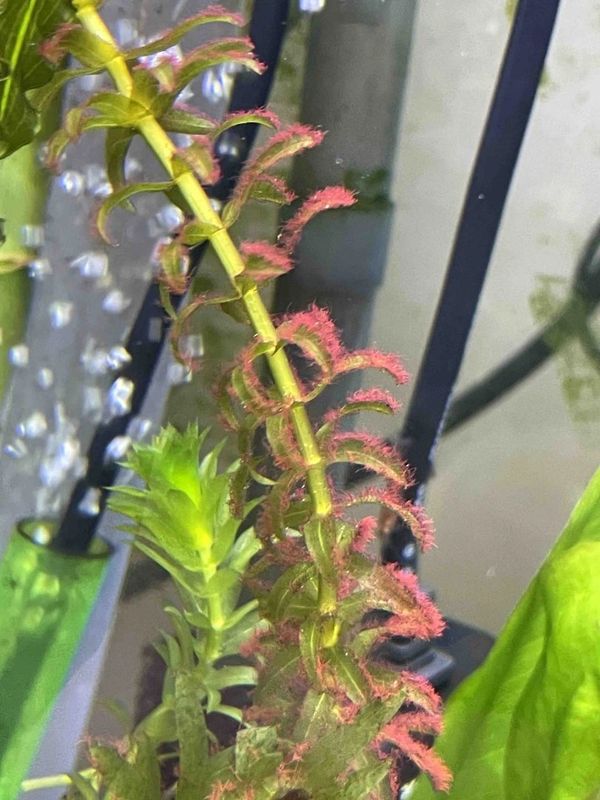- Home
- Reverse Respiration
- Tales from the Crypts
- The Chymatous Zones
- Pressure Tactics
- CO2 Saturation Over Time
- SnailsWormsAlgaeDiatoms
- A Tough Egg to Crack
- Algae Expiration
- pH Shifting
- Chlorophyll-A Affects/pH
- Algae Destruction from Re
- Timing is Everything
- Too Much of a Good Thing
- Night & Day
- Nothing and Something
- The Solution=The Solution
- INSTRUCTIONS
- In Memoriam
- Growth Stimulation
- Probable Improbabilities
- References
- Questions or Comments?
- Testimonials
- Upcoming Projects
The Tolva Effect - algae denatured by Reverse Respiration

Reverse Respiration as an Algicide
While working on another project with plants soaking in the CO2 solution for an approximately a 12-hour period, something very unexpected was noted. It involved various plants covered in various algae. Green Hair algae (GHA), Green Fuzz algae (GFA), Green Spot algae (GSA), Black Beard algae (BBA), Staghorn algae, as well as some plants completely coated and suffocating from brown Diatoms. At the end of the time period, the unused plants were placed back in the aquarium.
But WAIT...where are the plants covered in brown diatoms? There they were appearing completely diatom free and vibrant once again. A mystery is afoot! The other plants and algae were examined. The green fuzz/hair algae appeared lighter, some near white and opaque. Other algae appeared unaltered.
- The plants were returned to the aquarium for the evening.
- Almost every shrimp in the tank converged on all types of dead algae.
- In the morning the brown diatom plants still had no trace of brown to the naked eye.
- The green hair/fuzz was entirely white and opaque and had been mostly consumed by the shrimp or dissolved.
- Plant leaves almost entirely covered with green spot algae were now partially cleaned of the GSA.
- The real shock was the plant nearly covered in black beard algae (BBA) and staghorn. All of the BBA and staghorn turned blazing red and was being consumed or dissolving.

A second test of this resulted in the same alteration to the algae but was instead was returned to a tank with no inhabitants that would consume the altered algae. Over the course of 72 hours, all types except GSA dissolved on their own. The GSA saw about half fall off. However, 100% of the GSA died and no more grew.
In yet another example, here we have BBA treated with Reverse Respiration but there were no animals in the tank that would consume it so it’s action as an algicide is on display (left).
Without any predators to consume the killed algae, the BBA turns white and slowly falls off. At this point the prior project was paused and we investigated this avenue.
We simply had to know why it kills all algae, but not plants.

Right: Diatoms after 12 hours in CO2 solution---all enzymes (brown) are gone, leaving hollow cell walls and chlorophyll-a (green) remnants.
We found the best potential for explaining our observations to be with diatoms. Diatoms have a different ratio of content such that there’s more achlorophyllous cytoplasm (brown enzymatic contents) than green chlorophyll as opposed to common algae, yet it contains both.
This seemed ideal to test this theory as if it dissolved most of the brown content (achlorophyllous cytoplasm), but the green, chlorophyllic content remained, it strongly points towards pH shifting.
We found that virtually all of the algae proteins and enzymes are removed by Reverse Respiration, leaving expired or hollowed algae cells or cells simply incapable of a metabolic process. Only chlorophyll-a remains such that the algae and even diatoms still appear bright green or form green patches due to the intense CO2 saturation of the chlorophyll-a (see below). However, in our testing, 100% of the algae samples turned red or white and died as they no longer had any metabolic activity.

BBA before and after CO2 treatment

Hair Algae before and after CO2 treatment

Diatoms before and after CO2 treatment

GSA before and after CO2 treatment

Left: Healthy BBA - Denatured BBA
In all instances, we found most of the cell’s content is largely gone (denatured), leaving large gaps in and between the cells.
Once again, the only enzymatic remnant we found was chlorophyll-a, hence the dark green (darker here as they are stained for the microscope) in all of the images. Chlorophyll-a remained because it is the only one stable in a pH of only 3 but chlorophyll-a alone is not enough for metabolic processes to continue so the algae perish.
About Kerry Tolva

Award Winning Breeder...
Kerry Tolva Feitler performed the lion's share of the research on the effects of Reverse Respiration on many forms of algae. She has won many fishkeeping and breeders awards, with eight of the Breeder Awards in the past two years alone. These include:
Level-1-Star Breeder-Lancaster BAP-2025
Level-2-Star Breeder-Lancaster BAP-2025
Level-3-St
Kerry Tolva Feitler performed the lion's share of the research on the effects of Reverse Respiration on many forms of algae. She has won many fishkeeping and breeders awards, with eight of the Breeder Awards in the past two years alone. These include:
Level-1-Star Breeder-Lancaster BAP-2025
Level-2-Star Breeder-Lancaster BAP-2025
Level-3-Star Breeder-Lancaster BAP-2025
Class 2-Lancaster
BAP-2025
Class 10-Lancaster
BAP-2025
BAP-Aquarium Club of Lancaster-Novice Breeder of the Year-2024
BAP-Aquarium Club of Lancaster-Breeder of the Year (Points)-2024
BAP-Aquarium Club of Lancaster-Breeder of the Year (Species)-2024
- Tales from the Crypts
- The Chymatous Zones
- Pressure Tactics
- SnailsWormsAlgaeDiatoms
- A Tough Egg to Crack
- Algae Destruction from Re
- Timing is Everything
- Too Much of a Good Thing
- Night & Day
- Nothing and Something
- The Solution=The Solution
- INSTRUCTIONS
- In Memoriam
- Growth Stimulation
- Probable Improbabilities
- References
- Questions or Comments?
- Testimonials
- Upcoming Projects

Announcements
1. Reverse Respiration has a sister website! Visit us at: watercolorstestchart.com
2. Reverse Respiration has been awarded a U.S. Patent!
3.If you use the API test kit, you need WATERCOLORS!